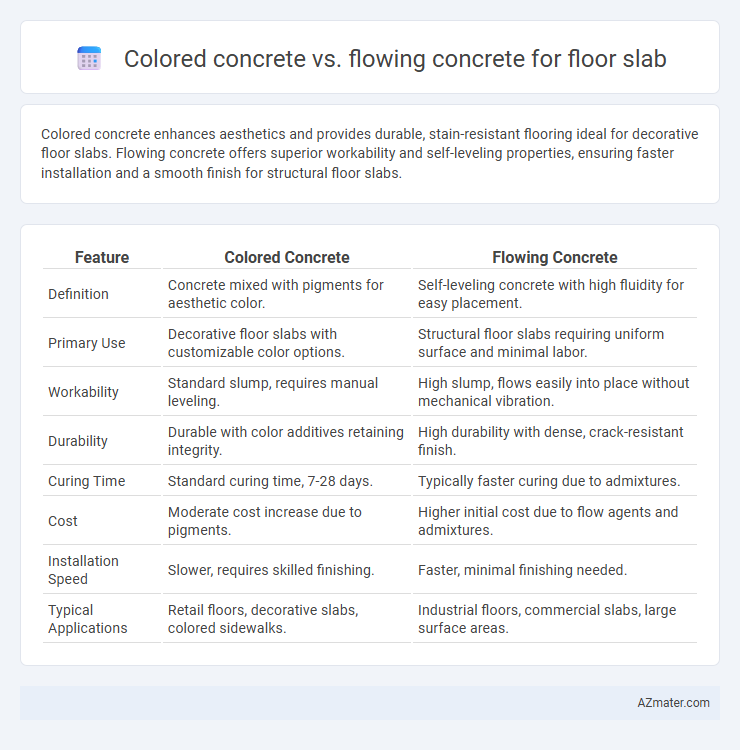Colored concrete enhances aesthetics and provides durable, stain-resistant flooring ideal for decorative floor slabs. Flowing concrete offers superior workability and self-leveling properties, ensuring faster installation and a smooth finish for structural floor slabs.
Table of Comparison
| Feature | Colored Concrete | Flowing Concrete |
|---|---|---|
| Definition | Concrete mixed with pigments for aesthetic color. | Self-leveling concrete with high fluidity for easy placement. |
| Primary Use | Decorative floor slabs with customizable color options. | Structural floor slabs requiring uniform surface and minimal labor. |
| Workability | Standard slump, requires manual leveling. | High slump, flows easily into place without mechanical vibration. |
| Durability | Durable with color additives retaining integrity. | High durability with dense, crack-resistant finish. |
| Curing Time | Standard curing time, 7-28 days. | Typically faster curing due to admixtures. |
| Cost | Moderate cost increase due to pigments. | Higher initial cost due to flow agents and admixtures. |
| Installation Speed | Slower, requires skilled finishing. | Faster, minimal finishing needed. |
| Typical Applications | Retail floors, decorative slabs, colored sidewalks. | Industrial floors, commercial slabs, large surface areas. |
Introduction to Concrete Flooring Options
Colored concrete offers a vibrant and customizable aesthetic for floor slabs, incorporating pigments that enhance visual appeal and provide long-lasting durability. Flowing concrete, known for its self-leveling properties, ensures a smooth and even surface ideal for large-scale floor slabs requiring minimal finishing labor. Both options cater to specific functional and decorative needs, making them suitable choices based on project requirements and design preferences.
What is Colored Concrete?
Colored concrete is a decorative material obtained by adding pigments or dyes to standard concrete mixtures, resulting in vibrant, durable, and customizable floor slabs. It offers enhanced aesthetic appeal and is ideal for enhancing visual design in residential, commercial, and industrial flooring applications. Unlike flowing concrete, which emphasizes workability and smooth finish, colored concrete focuses on visual customization while maintaining structural integrity.
What is Flowing Concrete?
Flowing concrete, also known as self-compacting concrete, is a highly fluid mixture designed to flow easily into formwork without the need for mechanical vibration, ensuring uniform compaction and a smooth surface finish. Colored concrete incorporates pigments or dyes throughout its mix, providing aesthetic appeal while maintaining structural integrity, but it often requires traditional placement methods, including vibration, to prevent segregation. For floor slabs, flowing concrete offers superior workability and reduced labor costs, making it ideal for complex forms, whereas colored concrete focuses on visual customization with a standard consistency.
Key Differences Between Colored and Flowing Concrete
Colored concrete incorporates pigments to achieve customized hues, enhancing aesthetic appeal for floor slabs, while flowing concrete prioritizes workability and self-leveling properties through reduced viscosity. Colored concrete typically requires standard consistency and finishing techniques, whereas flowing concrete often contains additives like superplasticizers to ensure smooth spreading and minimize labor efforts. The choice between the two depends on whether visual design or ease of application and surface uniformity is the primary project goal.
Aesthetic Impact: Colored vs Flowing Concrete
Colored concrete offers vibrant, customizable hues that enhance floor slab aesthetics with durable, fade-resistant pigments, making it ideal for decorative applications. Flowing concrete, also known as self-leveling concrete, provides a smooth, uniform surface that emphasizes sleekness and modern minimalism but typically lacks integral coloration, often requiring additional staining or treatments for aesthetic variation. Selecting between colored and flowing concrete depends on the desired combination of color vibrancy and surface smoothness for floor slab design.
Installation Process Comparison
Colored concrete installation requires precise mixing of pigments with cement to ensure uniform color distribution across the floor slab, followed by careful pouring and finishing to avoid color inconsistencies. Flowing concrete, also known as self-leveling concrete, simplifies the installation by eliminating the need for extensive manual leveling, as its high fluidity allows it to spread and settle evenly with minimal labor. Both types demand clean, well-prepared subfloors, but flowing concrete reduces time and effort in achieving a smooth surface compared to the more labor-intensive process of finishing colored concrete.
Durability and Performance Factors
Colored concrete offers enhanced aesthetic appeal and maintains high durability through UV-resistant pigments that prevent fading and surface degradation. Flowing concrete, also known as self-leveling concrete, provides superior performance in floor slabs by ensuring uniform compaction, reducing voids, and minimizing cracking under load stress. Both concretes deliver robust structural integrity, but flowing concrete generally excels in achieving smoother finishes and better load distribution, crucial for long-term slab performance.
Cost Analysis of Colored and Flowing Concrete Slabs
Colored concrete slabs typically incur higher material costs due to the addition of pigments and specialized mixing processes, increasing overall project expenses compared to flowing concrete. Flowing concrete, characterized by its self-leveling properties, often reduces labor costs and installation time, offering a more cost-effective solution for large floor slabs. However, initial material savings in flowing concrete may be offset by limitations in aesthetic customization available with colored concrete.
Maintenance Requirements for Each Type
Colored concrete for floor slabs requires regular sealing and cleaning to prevent staining and fading, maintaining its aesthetic appeal over time. Flowing concrete, known for its self-leveling properties, demands less frequent surface maintenance but may need periodic inspection for cracks due to its thinner application. Both types benefit from proper curing and moisture control to extend lifespan and reduce repair costs.
Choosing the Right Concrete for Your Floor Slab
Colored concrete offers aesthetic appeal with customizable hues and patterns ideal for decorative floor slabs, while flowing concrete, also known as self-leveling concrete, provides superior workability and smooth finish for uneven subfloors. For high-traffic areas requiring durability and visual impact, colored concrete enhances design versatility, whereas flowing concrete ensures optimal flatness and structural integrity in functional spaces. Selecting the right concrete depends on balancing visual requirements with performance needs, considering factors such as subfloor condition, usage, and maintenance.

Infographic: Colored concrete vs Flowing concrete for Floor Slab
 azmater.com
azmater.com